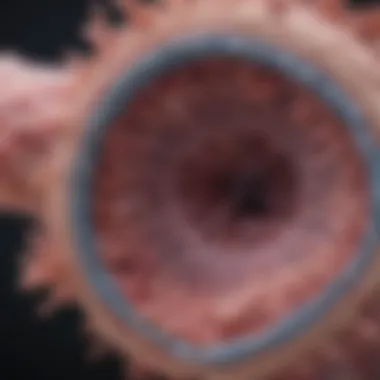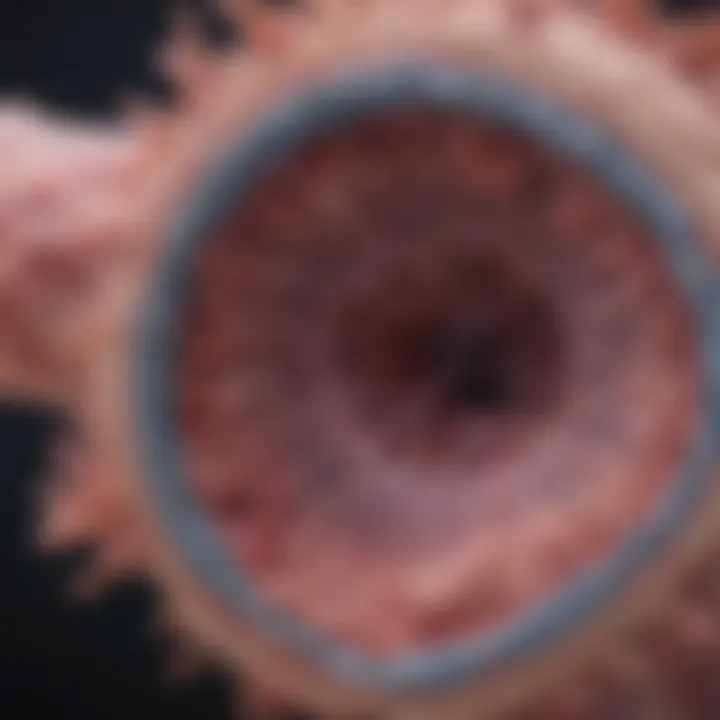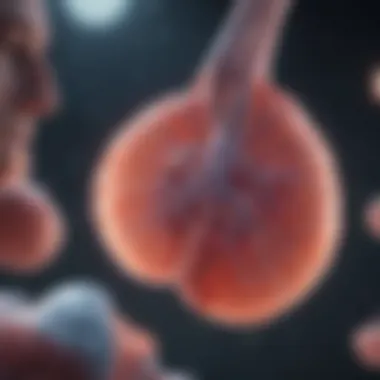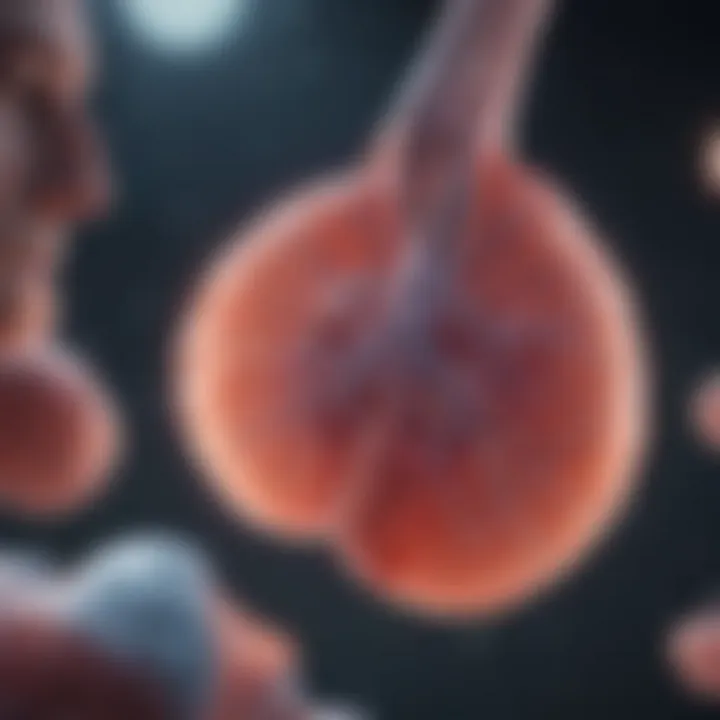Can Your Lungs Regenerate? Understanding Pulmonary Healing


Intro
The human lungs are vital organs, crucial for respiration and overall health. Understanding their regenerative capabilities brings hope for treatments in pulmonary diseases. In recent years, research has advanced our knowledge on how lung tissues can heal after injury. This article delves into the complexities of pulmonary regeneration, highlighting essential facets of this intriguing subject.
Article Overview
Purpose of the Article
The purpose of this article is to explore the current understanding of lung regeneration. We aim to dissect the mechanisms that allow for repair after injury. By examining scientific literature, we provide insights derived from various research studies focused on regenerative potential in the lungs. This examination extends beyond mere curiosity; it holds implications for approaches to combat chronic diseases affecting lung function.
Relevance to Multiple Disciplines
The implications of lung regeneration touch upon several fields:
- Medicine: For practitioners, comprehending lung repair can inform treatment strategies for conditions such as asthma, COPD, and pulmonary fibrosis.
- Biology: Researchers in pulmonary biology investigate the cellular mechanisms that permit regeneration, contributing to broader knowledge of tissue repair.
- Biomedical Engineering: Innovative technologies may emerge from an understanding of lung regeneration, leading to advancements in medical devices and therapies.
By framing our inquiry across these disciplines, we highlight the interdisciplinary nature of lung regeneration.
Research Background
Historical Context
Historically, lung tissue was viewed as static, with little capacity for recovery. However, key research breakthroughs have changed the paradigm, revealing that, under certain conditions, the lungs possess remarkable abilities to repair and regenerate.
Key Concepts and Definitions
To facilitate understanding, it's necessary to establish definitions for core concepts:
- Regeneration: This refers to the process through which cells are replaced or repaired following injury.
- Pulmonary Injury: This encompasses damage caused by environmental factors, pathogens, or chronic diseases.
- Stem Cells: These are undifferentiated cells with the potential to develop into different cell types, playing a role in tissue repair.
In our exploration, we will return to these concepts continuously to elucidate their relevance.
"The potential for lung tissue regeneration may significantly reshape how we view treatment options for chronic pulmonary diseases."
"The potential for lung tissue regeneration may significantly reshape how we view treatment options for chronic pulmonary diseases."
Effective healing mechanisms serve as a foundation for this article. Understanding regeneration may open new avenues for innovative therapies designed to promote recovery in damaged lung tissues.
Prelims to Lung Regeneration
The process of lung regeneration is a critical subject in the field of pulmonary biology. Understanding this topic is important due to the rising incidence of lung diseases and the potential for developing effective therapies. Environmental factors and lifestyle choices put a strain on lung health, leading to injuries that require potent repair mechanisms. Investigating lung regeneration leads to insights on how the lungs recover from damage, as well as the implications for treatment options available for lung disorders.
Lung regeneration refers to the physical and functional restoration of lung tissues after injury or damage. This regeneration is essential for maintaining respiratory efficiency and overall health. The intricate biology of the lungs enables part of it to heal, but this process is sometimes inadequate depending on the extent of the injury and individual health factors. By diving deep into this subject, we uncover mechanisms of recovery that may lead to breakthroughs in therapy for chronic conditions affecting the lungs.
Understanding the regeneration capabilities of lungs holds benefits not only for patients but also for researchers and healthcare professionals. It opens avenues for innovative treatment strategies, enhances our knowledge of pulmonary health, and underlines the importance of preventative measures against lung damage.
In summary, the significance of lung regeneration lies in its intricate connection to overall lung health, treatment advancements, and the hope it brings to individuals affected by pulmonary diseases. Through thorough research and analysis, it becomes possible to better understand this complex topic.
Anatomy and Function of the Lungs
Understanding the anatomy and function of the lungs is essential when exploring the regenerative capacity of lung tissue. The lungs are complex organs that play a crucial role in respiration, facilitating gas exchange and maintaining homeostasis within the body. A comprehensive review of their structure and function reveals important aspects that influence how lung injuries may heal and regenerate.
Structural Overview
Bronchi
The bronchi are the primary air passages that branch from the trachea into each lung. Each bronchus divides into smaller bronchioles, leading to the alveoli. One significant feature of the bronchi is their cartilage rings, which help keep the airways open during breathing. The presence of ciliated epithelial cells also aids in clearing mucus and debris from the airways. This characteristic makes the bronchi vital for maintaining clear airways and facilitating air flow, thus playing a role in overall lung health.
However, factors like chronic irritation from smoking can damage these structures, impacting their function and hindering natural repair processes. As research advances, understanding how bronchi can regenerate post-injury becomes more essential.
Alveoli
Alveoli are the microscopic air sacs located at the end of the bronchioles. They are the primary sites for gas exchange, allowing oxygen to enter the blood and carbon dioxide to exit. The unique feature of alveoli is their extensive surface area, maximized by their grape-like clusters. This makes them fundamental for efficient gas exchange in humans. Damage to alveoli is often irreversible, particularly in diseases like emphysema, yet some small scale recovery has been observed in young, healthy individuals.
Progress in understanding alveolar regeneration could open doors to therapies aimed at enhancing or supporting recovery from lung injuries.
Pleura
The pleura are thin membranes that envelop the lungs, providing a smooth surface for the lungs to expand and contract during breathing. Their key characteristic lies in facilitating frictionless lung movements. However, pleural complications, such as pleuritis, can lead to significant pain and breathing difficulties. This highlights the importance of maintaining pleural health for optimal lung function. While the pleura do not directly contribute to gas exchange, their role is central in ensuring that the lungs can function effectively without obstruction.
Physiological Functions
Gas Exchange
Gas exchange is arguably the most critical physiological function of the lungs. It is essential for transporting oxygen to the body's tissues and removing carbon dioxide. The efficient workings of the lungs are characterized by their ability to respond quickly to changes in activity levels and metabolic needs. This dynamic system allows for effective performance in both rest and exertion.
Regulation of pH
The lungs are instrumental in regulating the body's pH level. Through the exhalation of carbon dioxide, they help maintain acid-base balance, which is crucial for various enzymatic reactions and metabolic processes. The ability of the lungs to modulate pH demonstrates their significant role in homeostasis and overall health.


Immune Defense
The lungs possess an intricate immune defense system, which includes mucous production and the presence of specialized immune cells. This system acts as a barrier against pathogens and pollutants. Understanding these defense mechanisms enhances comprehension of how the lungs respond to damage and the potential for regeneration. Effective lung defense is vital in preventing infections and diseases that could impede the healing process.
Understanding Lung Damage
Understanding lung damage is critical to exploring the regenerative capacity of the lungs. The lungs are vulnerable to various factors that can lead to injury, impacting their ability to function adequately. This section delves into the types and causes of lung damage, laying the groundwork for recognizing how injuries can affect pulmonary biology and subsequent repair mechanisms.
Types of Lung Injuries
Acute Injury
Acute lung injury occurs suddenly and results from an immediate negative impact on pulmonary function. The hallmark of acute injury is its rapid onset. This type of injury is significant because it triggers swift physiological responses often meant to prevent further harm.
The unique feature of acute injury is the inflammatory response it initiates. While the inflammation serves to protect and heal, it can also lead to swelling and fluid accumulation, complicating recovery. Acute injuries primarily affect individuals exposed to sudden hazards, such as chemical exposures or severe infections. They often need immediate medical attention to stabilize lung function, illustrating the importance of recognizing symptoms early.
Chronic Injury
Chronic injury unfolds gradually, typically due to long-term exposure to damaging substances or ongoing health conditions. Its key characteristic lies in persistent changes to lung structure and function, which may lead to debilitating conditions over time. Chronic injury often reflects lifestyle choices or environmental factors that accumulate damage, such as smoking or air pollution.
Chronic injuries represent a significant area of concern because their long-lasting effects can be more challenging to reverse. The chronicity of these injuries often leads to diseases such as Chronic Obstructive Pulmonary Disease (COPD), making it essential for individuals to manage risk factors effectively.
Infectious Damage
Infectious damage occurs when pathogens invade lung tissue, causing inflammation and impairing function. This type of damage is often a result of respiratory infections such as pneumonia or viral infections like COVID-19. The distinctive aspect of infectious damage is its potential to lead to acute or chronic outcomes, depending on the severity and treatment effectiveness.
Infectious damage serves as a crucial point of discussion because it can precipitate rapid deterioration in lung health. Moreover, understanding how infections affect respiratory health can help in developing preventative strategies and therapeutic approaches. The ability of the lungs to recover from infectious damage relies heavily on the immune response and the overall health of the individual.
Causes of Lung Damage
Environmental Toxins
Environmental toxins represent a significant causative factor in lung damage. These toxins often include pollutants like particulate matter, heavy metals, and chemicals found in industrial settings. The critical aspect of environmental toxins is their pervasive nature, as they can infiltrate airways without individuals' notice until symptoms emerge.
The unique feature of environmental toxins is their insidious effect over time. While acute symptoms may prompt immediate attention, chronic exposure can lead to progressive lung diseases. Thus, understanding their impact is vital for both individuals and public health policies aimed at reducing exposure.
Infections
Infections are another primary cause of lung damage that can occur via various pathogens, including viruses, bacteria, and fungi. They create specific challenges in lung healing and regeneration owing to their direct assault on pulmonary tissues. The characteristic aspect of infections is their potential to not only cause acute symptoms but also result in long-term damage, altering lung health significantly.
Infections can complicate existing lung diseases, making early detection and treatment essential. By addressing infectious causes, we can help mitigate their overall effect on lung health.
Chronic Diseases
Chronic diseases include a range of conditions such as asthma, COPD, or pulmonary fibrosis that lead to gradual lung damage. The defining feature of chronic diseases is their sustained impact on lung function over time.
No doubt, chronic diseases hold substantial weight in discussions of lung regeneration because they not only harm lung tissue but also influence the potential for recovery. Managing these conditions effectively through lifestyle changes, medication, and therapy is crucial in safeguarding lung health and enhancing regenerative capacity.
Mechanisms of Lung Repair
Understanding how lungs repair themselves is crucial in comprehending pulmonary health. This section gives insights into the mechanisms behind lung repair, focusing on the cellular responses and the role of stem cells. Recognizing these mechanisms can help in developing treatments for various lung conditions, thus emphasizing their importance in the medical field.
Cellular Response to Injury
Inflammatory Response
The inflammatory response is the body’s initial reaction to lung injury. This process is marked by the recruitment of various immune cells to the site of damage. The key characteristic of this response is its speed, which allows for the immediate containment of potential pathogens. In the context of lung repair, the inflammatory response serves as a double-edged sword. On one hand, it facilitates healing by clearing debris and pathogens, making way for regeneration. On the other hand, prolonged inflammation can lead to additional damage, which makes it important to balance this response.
Unique features of the inflammatory response include the release of cytokines and growth factors that can influence healing. While it is beneficial for initiating repairs, excessive inflammation can delay the healing process or lead to fibrosis, complicating recovery.
Epithelial Repair
Epithelial repair is essential for restoring the barrier function of the lungs after injury. This process involves the proliferation and migration of epithelial cells to cover damaged areas. A key characteristic of epithelial repair is its ability to quickly restore the integrity of the lung surface.
This type of repair is particularly important in cases of mild to moderate lung injuries. It stands out because it allows the lungs to resume normal functions rapidly. However, insufficient epithelial repair can result in chronic lung issues, indicating a need for efficient recovery mechanisms.
Fibroblast Activation
Fibroblast activation plays a significant role in the repair process, especially in areas where damage has led to the destruction of lung tissue. Fibroblasts are vital for the synthesis of extracellular matrix components, which provide structural support during healing. The key characteristic of fibroblast activation is its role in scar formation and tissue remodeling.
While fibroblast activation is necessary for repairing tissue integrity, it can also lead to complications such as pulmonary fibrosis. The unique feature of fibroblast activity in lung repair lies in its dual nature; it can facilitate healing but can also contribute to long-term lung damage if uncontrolled.
Role of Stem Cells
Adult Stem Cells
Adult stem cells are integral to lung repair mechanisms. They have the ability to differentiate into various cell types necessary for regenerating damaged tissue. The key characteristic of adult stem cells is their plasticity, which allows them to adapt and contribute to the repair process effectively.
These stem cells are a popular focus of research due to their potential in regenerative medicine. Their unique feature is that they reside in various lung compartments, making them accessible for therapeutic interventions. However, their effectiveness can diminish with age or chronic disease.


Their Sources
The sources of stem cells relevant to lung repair include bone marrow and specific lung niches. The key characteristic of these sources is their accessibility for harvesting stem cells for research and potential therapies. This accessibility makes them a beneficial choice for developing targeted treatments.
The unique feature of stem cells from these sources lies in their ability to be mobilized during injury situations, helping in the repair processes. However, challenges include understanding how to effectively stimulate these cells to enhance their regenerative capacity.
Potential for Regeneration
The potential for regeneration in lungs is significant, yet it is also limited by various factors. The key characteristic of this potential is linked to the lung's ability to undergo remodeling and repair after injuries. This characteristic makes it a subject of great interest in pulmonary research.
The unique feature of regenerative potential is its preservation in younger individuals, leading to better recovery rates. However, factors such as age, smoking, and environmental toxins can hinder this process, often resulting in chronic lung diseases. Understanding this balance can lead to advancements in regenerative therapies.
Factors Influencing Regeneration
Lung regeneration is a complex process influenced by various factors. Understanding these factors is crucial to comprehend how repair mechanisms function and to identify interventions that might enhance lung healing. A combination of biological age and lifestyle choices can significantly affect the lungs' regenerative capacity. This section analyzes these elements, with emphasis on their implications.
Age-Related Changes
As individuals age, the natural regenerative abilities of the lungs diminish. Older adults often display decreased lung function due to structural changes. The elasticity of lung tissue tends to reduce, making gas exchange less efficient. Furthermore, age may impair the repair mechanisms of the epithelium and alveoli after injury. This decreased ability to heal can lead to chronic issues if lung damage occurs, contributing to the overall decline in respiratory health.
Impact of Lifestyle Choices
Lifestyle choices play a significant role in lung health. Several behaviors can enhance or hinder lung regeneration.
Smoking
Smoking is a leading cause of preventable disease worldwide. With toxic substances, smoking damages lung tissues, leading to inflammation and fibrosis. The key characteristic of smoking is that it introduces harmful chemicals into the lungs, which in turn initiate a chronic inflammatory response. This response can lead to the destruction of the alveoli, the sites responsible for gas exchange. Smoking not only hinders lung regeneration but also contributes to chronic conditions such as COPD.
Diet
Diet influences overall health and lung function uniquely. A balanced diet rich in antioxidants and essential nutrients can support lung health. For instance, foods high in vitamin C and omega-3 fatty acids may help in reducing inflammation and promoting repair processes. However, poor dietary choices, such as high sugar and processed food consumption, can lead to obesity, which may further strain the lungs. This is critical as obesity-related inflammation can impede lung healing.
Exercise
Regular exercise contributes positively to lung capacity. Physical activity enhances ventilation and promotes better oxygenation of blood. Aerobic exercises, such as running or cycling, strengthen respiratory muscles and improve overall lung function. Importantly, exercise can also stimulate various growth factors that signal repair processes in lung tissue. However, extreme levels of exertion, particularly in polluted environments, can present respiratory challenges. Thus, moderate exercise is generally advisable for supporting lung regeneration.
In understanding the factors influencing lung regeneration, it is evident that age and lifestyle choices significantly shape the health of lung tissue. Cumulatively, these factors play a pivotal role in determining the lungs' ability to heal from injuries. The integration of proper nutrition, cessation of smoking, and regular physical activity can enhance lung health and bolster regenerative processes.
Regenerative Capacity of the Lungs
The regenerative capacity of the lungs is an area of significant interest in pulmonary biology. Understanding this capacity is crucial for addressing lung injuries and chronic diseases, which continue to affect millions worldwide. Lung tissue has a remarkable ability to repair itself after mild injuries, but when damage becomes extensive, the self-healing mechanisms can become significantly limited. This raises questions about the conditions under which lung tissue can recover and the implications for treatments.
Limitations of Lung Self-Healing
Lung self-healing has inherent limitations that deserve attention. The lungs are composed of specialized cells that can regenerate, yet certain factors can hinder this process. Age plays a vital role; as individuals grow older, the regenerative capacity of lung tissue diminishes. Moreover, persistent exposure to environmental toxins, such as pollution or cigarette smoke, can lead to chronic damage, making it challenging for the lungs to heal effectively.
Furthermore, when lung injuries are severe, the normal healing processes can become disordered. Fibrosis, characterized by excessive scarring, can result in lost lung function. Essentially, while the lungs can regenerate to some degree, their ability is influenced by external and internal factors.
Successful Cases of Regeneration
Post-Exercise Recovery
One striking aspect of lung regeneration is observed in post-exercise recovery. After engaging in physical activity, the lungs can enhance their efficiency and capability. This phenomenon is not merely anecdotal; it highlights how regular exercise can lead to improvements in lung function and overall health. The key characteristic of post-exercise recovery is its ability to stimulate the lung tissue, promoting better air exchange and reducing the risk of chronic conditions.
The unique feature of this recovery is that it serves as a natural and accessible method for improving lung health. Regular aerobic exercises, like running or swimming, can help strengthen respiratory muscles and enhance lung capacity. As a result, an active lifestyle is viewed as a favorable choice for individuals looking to optimize lung health. However, it is essential to recognize that not everyone may experience the same level of recovery; underlying health issues can present challenges in this regard.
Youth Recovery after Injury
Youth recovery after injury presents another compelling case of lung regeneration. Younger individuals generally exhibit a higher capacity for healing compared to older adults. This is primarily due to more robust cellular mechanisms that support regeneration. The key characteristic of youth recovery lies in the body's inherent biological resilience and its ability to repair damaged tissue more effectively.
This unique feature provides potential advantages for addressing lung injuries sustained during activities such as sports. Young individuals often recover faster and return to optimal lung function more quickly than older individuals. However, it is also important to note that certain injuries can lead to long-term complications, even in youth. Hence, while the prospects for regeneration are promising, caution must be exercised to prevent further harm.
Lung Diseases and Their Impact on Regeneration
Lung diseases significantly affect the regenerative capabilities of the lungs. Understanding the interplay between these diseases and the lungs' healing processes is vital. Each disease presents unique challenges to lung repair and regeneration. This section covers some prominent conditions, including Chronic Obstructive Pulmonary Disease and Pulmonary Fibrosis, and their implications for lung regeneration.
Chronic Obstructive Pulmonary Disease (COPD)
Chronic Obstructive Pulmonary Disease (COPD) is a progressive lung disease characterized by long-term breathing problems and poor airflow. It encompasses chronic bronchitis and emphysema. This disease leads to inflammatory responses that damage lung tissue, making regeneration harder. The persistent inflammation overwhelms the body's natural repair mechanisms.
In COPD, lung cells undergo structural changes. The airways become narrowed, and the alveoli lose their elasticity. These alterations impede effective gas exchange. The constant cycle of injury and repair becomes maladaptive. As a result, the lungs are less capable of regenerating healthy tissue.
Management of COPD often includes lifestyle changes, medications, and therapies. Addressing air quality and reducing exposure to irritants can slow disease progression. The incorporation of bronchodilators can ease airflow and therefore support lung function. However, when lung tissue is extensively damaged, regeneration may not occur, highlighting the importance of prevention and early intervention.
Pulmonary Fibrosis
Pulmonary Fibrosis is a condition that results in scarring of lung tissue. The formation of scar tissue reduces lung capacity and hampers the lungs' ability to function properly. This progressive disease impairs the normal architecture of lung tissue, making the repair processes less effective.
In Pulmonary Fibrosis, the extracellular matrix becomes excessively deposited, leading to stiff and less compliant lungs. The cellular environment is disrupted, undermining the mechanisms necessary for regeneration. Patients often experience symptoms like shortness of breath and chronic cough, which can restrict their daily activities.


Treatment options for Pulmonary Fibrosis remain limited. Antifibrotic therapies aim to slow the progression of the disease but do not reverse lung damage. This scenario emphasizes the need for ongoing research into effective treatment strategies that could enhance pulmonary regeneration. Innovations like gene therapies hold promise, aiming to restore the regenerative properties of lung cells.
The connection between specific lung diseases and regeneration is complex. It shows that while the lungs have some capacity for self-repair, certain conditions can greatly limit this ability.
The connection between specific lung diseases and regeneration is complex. It shows that while the lungs have some capacity for self-repair, certain conditions can greatly limit this ability.
In summary, both COPD and Pulmonary Fibrosis provide insights into the challenges that diseases impose on lung regeneration. The impact of lung diseases on regeneration underscores the necessity to promote lung health. Hence, addressing the causes and improving treatment options are essential in enhancing patients' quality of life.
Emerging Therapies for Enhancing Lung Regeneration
The field of lung regeneration is advancing rapidly, primarily through the exploration of emerging therapies. Understanding these therapies is crucial for addressing lung injuries and diseases effectively. They hold the potential for restoring lung function and promoting healing in damaged tissues. By focusing on the latest developments such as stem cell therapies and gene therapy, we can gain insight into innovative approaches for enhancing lung regeneration.
Stem Cell Therapies
Current Research
Current research in stem cell therapies is gaining attention due to its ability to promote lung tissue regeneration. This aspect of research focuses on the use of various types of stem cells, particularly adult stem cells, to repair lung damage. Recent studies have demonstrated that stem cells can differentiate into specialized lung cells, providing a leap forward in regenerative medicine. The key characteristic of current research is its emphasis on preclinical and clinical applications. It serves as a foundation for understanding how stem cells interact with lung tissues. This makes it a particularly beneficial choice in this article because it highlights a promising area of research that could change lung treatment methodologies.
Moreover, a unique feature of this research lies in its adaptability. It can potentially evolve based on findings from ongoing studies. However, challenges remain, such as ensuring the safety and efficacy of these therapies. Further research is needed to understand optimal dosages and delivery methods to maximize benefits.
Clinical Trials
Clinical trials represent a vital component of the progression of stem cell therapies. These trials test the effectiveness and safety of new treatments. The significance of clinical trials is clear, as they provide the necessary data to support or refute the viability of stem cell therapies in lung regeneration. One notable aspect of clinical trials is their structured design, which allows for systematic evaluation and comparison. This structured approach makes trials a founding pillar in evidencing the viability of therapies discussed in this article.
A unique feature of clinical trials is their ability to gather real-world evidence on treatment outcomes. They also assess the feasibility of implementing therapies on a large scale. While promising, clinical trials are not without disadvantages. They can be resource-intensive and may take time to yield results, which can delay accessibility to effective treatments for patients.
Gene Therapy
Mechanisms
Gene therapy is another potential trailblazer in lung regeneration, focusing on correcting genetic defects and enhancing the body's ability to heal itself. Mechanisms of gene therapy are diverse but typically involve delivering therapeutic genes to the lungs using viral vectors. This method can effectively target damaged cells and restore normal function. The key characteristic of mechanisms in gene therapy is their precision in addressing specific genetic issues in lung cells. This makes it particularly appealing due to its targeted approach, which can be more effective compared to traditional treatments.
Furthermore, a unique feature of gene therapy lies in its long-lasting effects. Once the therapeutic gene is introduced, it can continue to function within the cell, offering potentially sustained improvement in lung health. However, there are challenges related to the method of delivery and possible immune responses that can limit its effectiveness.
Applications
The applications of gene therapy are wide-ranging and promising. They can address various conditions affecting lung health, particularly genetic disorders and pulmonary diseases. A key characteristic of these applications is their broad spectrum, which underscores gene therapy's potential to treat everything from congenital conditions to chronic diseases.
One major advantage of applications in gene therapy is that they may not only treat but potentially cure underlying issues, providing long-term solutions for patients. The challenge lies in the complexity of these applications, as they require extensive research and development. Regulatory processes for gene therapies can also prolong the time before treatments are available to patients.
Gene therapy represents one of the most exciting frontiers in lung regeneration, with the potential to redefine how respiratory diseases are treated as research progresses.
Gene therapy represents one of the most exciting frontiers in lung regeneration, with the potential to redefine how respiratory diseases are treated as research progresses.
The Future of Lung Regeneration Research
The potential for lung regeneration continues to spark interest among researchers in the field of pulmonary biology. With a greater understanding of the mechanisms involved in lung damage and repair, science is poised to make significant strides. This future research aims to ultimately enhance lung health and address prevalent diseases. As we delve into this area, it is clear that innovative treatments and personalized medicine play pivotal roles.
Innovative Treatments on the Horizon
Recent developments indicate a promising future for lung regeneration. Researchers are exploring various advanced techniques that harness the body's natural healing processes. Some of the most noteworthy treatments that are emerging include:
- Stem Cell Therapies: These therapies aim to use specialized cells to repair damaged lung tissue. The application of stem cells is not limited to sourcing them from bone marrow or blood; researchers also look into amniotic fluid and other tissues.
- Gene Therapy: This involves correcting genetic defects that lead to lung diseases. By delivering specific genes to lung cells, there is potential to significantly improve lung function.
- Regenerative Medicine: This emerging field focuses on using growth factors and biomaterials to support lung tissue repair. Techniques in tissue engineering can create scaffolds to aid lung recovery.
While these methods present exciting possibilities, they require careful consideration and research. Each technique must undergo rigorous testing to ensure safety and efficacy.
The Role of Personalized Medicine
Personalized medicine is becoming increasingly important in understanding lung regeneration. It emphasizes tailoring treatment based on individual patient characteristics. This approach can lead to improved outcomes and more effective interventions. Several aspects highlight the significance of personalized medicine in lung research:
- Genomic Profiling: Analyzing a patient’s genetic makeup can help identify predispositions to certain lung diseases. By understanding these genetic factors, therapies can be better tailored to individual needs.
- Lifestyle Considerations: Factors such as smoking habits, diet, and exercise are crucial for lung health. Personalized treatment plans can incorporate lifestyle modifications that are specific to the individual, which enhance the potential for tissue regeneration.
- Customized Drug Treatments: Personalized medicine can guide the development of drugs that work better for specific genetic profiles, increasing their effectiveness for lung repair.
"Personalized medicine transforms the future of treatment, ensuring that therapies are not one-size-fits-all but rather tailored to the unique characteristics of each patient."
"Personalized medicine transforms the future of treatment, ensuring that therapies are not one-size-fits-all but rather tailored to the unique characteristics of each patient."
This intersection of personalized medicine and lung regeneration shows promise, indicating that future research will not only improve understanding but also lead to innovations in treating lung diseases.
The End
The exploration of lung regeneration is crucial for understanding how our pulmonary system responds to injury and aging. This field of study not only helps in recognizing our lungs' limitations but also highlights the potential pathways for repair and regeneration. The ability of the lungs to heal can lead to improved health outcomes for patients suffering from chronic respiratory issues. It emphasizes the importance of maintaining lung health through lifestyle choices and may promote advancements in medical treatments.
Summary of Findings
The analysis conducted throughout this article indicates that while lungs possess some degree of regenerative capacity, this capability often varies significantly between individuals due to several factors. Key findings include:
- Injuries and their Types: Different types of lung damage have distinct mechanisms of repair. Acute injuries tend to have a better prognosis than chronic or infectious ones.
- Cellular Mechanisms: The lungs rely on specific cellular responses, including inflammatory responses and epithelial repair mechanisms, facilitated by stem cells that play a crucial role.
- Influencing Factors: Age, lifestyle choices like smoking, and overall health significantly affect the lungs' ability to regenerate.
- Emerging Therapies: Innovative approaches, including stem cell and gene therapies, show promise in enhancing the regenerative capabilities of lung tissue.
These points underline the complexity of pulmonary regeneration, revealing both its potential and limitations.
Implications for Future Research
Future research in lung regeneration is critical for several reasons:
- Understanding Disease Mechanisms: Continued study is essential to fully comprehend how various lung diseases alter local cellular environments and impact repair mechanisms.
- Development of Targeted Therapies: Insights gained from research could pave the way for the creation of targeted treatments that could dramatically improve recovery from lung injuries and diseases.
- Potential for Personalized Medicine: As research progresses, the notion of personalized therapy can be realized, tailoring treatment approaches to individual patient needs based on their unique biological responses to lung injury.



